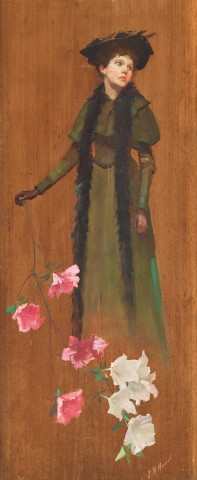PORTRAIT OF A LADY, c.1895
JULIAN ROSSI ASHTON
oil on wood panel
81.0 x 32.5 cm
signed lower right: J.R. ASHTON
Private collection, Melbourne
Christie’s, Melbourne, 14 March 1972, lot 45
Private collection, Melbourne
Thence by descent
Private collection, Melbourne
The Green Gown, c.1890, oil on panel, 66.0 x 24.5 cm, Sotheby’s, Sydney, 22 November 1992, lot 187
Bertha, 1894, oil on wood panel, 91.0 x 26.6 cm, The Stuartholme-Behan Collection of Australian Art, The University of Queensland, Brisbane
Young Woman with a Parasol, 1895, oil on wood panel, 89.0 x 25.0 cm, Deutscher and Hackett, Sydney, 28 April 2010, lot 24
Young Woman in Blue with Parasol, oil on panel, 89.5 x 25.5 cm, formerly in the Ian Callinan Collection, Brisbane
Artist, illustrator, teacher, Julian Rossi Ashton was a major and influential figure in the Australian art world for over fifty years. One of his memorable achievements was the acquisition of Arthur Streeton’s Still Glides the Stream, and Shall Forever Glide,1890 by the Art Gallery of New South Wales when he was a trustee (1889-1899). It was the first work by Streeton to enter a public collection. Ashton was a leading figure in the plein-air movement, which, in New South Wales, included A.J. Daplyn, Henry Fullwood, Girolamo Nerli and Charles Conder. Prominent as president of the Art Society of New South Wales and of the Society of Artists, Ashton organised the first exhibition of Australian art to travel abroad, being shown at London’s Grafton Gallery in 1898. Perhaps, however, he is best remembered as an inspiring teacher. Founder of the prestigious Sydney Art School (also known as the Julian Ashton Art School), a short role call of former students is impressive –George Lambert, Elioth Gruner, Thea Proctor, William Dobell, and John Passmore.
Painting on cedar and wooden panels was very popular in Australia in the late ‘eighties into the 1890s, particularly among the more advanced artists. In 1889, in Melbourne, there was the 9 x 5 Impression Exhibition and its favoured use of cedar cigar box lids. Memorable examples are Charles Conder’s A Dream of Handel’s Largo, 1889 (Art Gallery of South Australia, M.J.M. Carter Collection) and Streeton’s Honesty and Artichokes, 1889, (Wesley College, Melbourne, The Alec Cato Collection). Mention also should be made of Streeton’s Belinda, or, A Lady of the Period, 1894 in the Newcastle Art Gallery through the Dr Roland Pope Bequest. In 1895, Tom Roberts began a series of over twenty portraits, mainly on cedar panels, of prominent personalities. Key examples are George Coppin, c.1895-9 in the National Portrait Gallery, Canberra and Andrew Garran, c.1896 (private collection). The single female of Roberts’ group was the model and photographer, Ada Furlong, c.1895, in the Art Gallery of Western Australia. The similarity between Roberts’ and Ashton’s works suggests mutual influence.
A noted painter of portraits, Ashton’s works range from Portrait of Louis Buvelot, 1880 (Geelong Gallery), through to Spring (Miss Helen Willis), c.1889 (National Gallery of Australia). The stylish (Portrait of a Lady), c.1890s, like its companion piece, Young Woman with a Parasol, 1895, is modish of dress.1 The folded parasol held by the latter, however, has morphed into the red and white azaleas of the former. Appropriately, azaleas in all their beauty symbolise femininity and softness. Such floral additions and detailing are a particularly attractive feature of Ashton’s portraits of ladies. Also, he often shows them in profile, facing right. Touched by a French sophistication and elegance inherited from his student days in Paris, their immediacy of appeal is promoted by the direct application of paint onto the unprimed cedar panel. Another striking feature of these related works is the presentation of the figure from a lower viewpoint – visually arresting through elevation. While the question of the identity of the model for (Portrait of a Lady) has not been resolved, Ashton’s daughter Bertha is a possibility. Although young, a likeness can be found in the drawing, ‘female head’ on the verso of ‘(Bertha Ashton)’, in the Ashton sketchbook in the National Gallery of Australia. 2
1. For details of Young Woman with a Parasol, 1895, see ‘Related Work’
2. National Gallery of Australia, 77.59.3. 10AB
DAVID THOMAS
